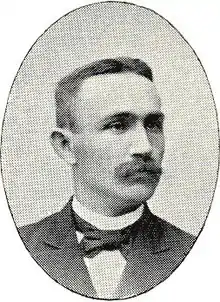Anders Wiman
Anders Wiman (11 February 1865 – 13 August 1959) was a Swedish mathematician.
Anders Wiman | |
|---|---|
 | |
| Born | 11 February 1865 Hammerlöf, Malmöhus County |
| Died | 13 August 1959 (aged 94) |
| Nationality | Sweden |
| Alma mater | Lund University |
| Scientific career | |
| Fields | Mathematics |
| Institutions | Uppsala University |
| Doctoral advisor | Carl Fabian Björling |
| Doctoral students | Arne Beurling Fritz Carlson |
Life
Wiman attained his doctorate from Lund University in 1892, under supervision of Carl Fabian Björling with thesis Klassifikation af regelytorna af sjette graden (Classification of regular surfaces of degree 6). He later taught at Uppsala University, where Arne Beurling and Fritz Carlson were among his students.
In 1904 Wiman was an Invited Speaker of the ICM in Heidelberg.[1] He was from 1908 an editor of Acta Mathematica.
Awards
He was elected a member of the Royal Swedish Academy of Sciences in 1905.
Work
He introduced Wiman's sextic curve.
The main focus of his research was algebraic geometry and applications of group theory to geometry and function theory. He proved that for n > 7, in less than n–2 dimensions, there are no groups of collineations that are isomorphic to the symmetric or alternating group on n symbols. He also determined all finite groups of birational transformations of the plane.[2] Wiman wrote the article on finite groups of linear transformations for Klein's encyclopedia. In function theory he did important work on entire functions. From 1914 to 1916 he introduced what is now called Wiman-Valiron theory (named after him and Georges Valiron).[3][4][5] Wiman's generalization of a theorem of Hadamard is known as Wiman's theorem.[6][7] His investigations on the zeros of the derivatives of entire functions — along with similar investigations by George Pólya – had a great influence on the theory of entire functions; in particular, the now-proved Wiman conjecture,[8] [9] and the now-proved Pólya-Wiman conjecture[10] have inspired much research.
References
- "Die metazyklischen Gleichungen 9. Grades von A. Wiman". Verhandlungen des dritten Mathematiker-Kongresses in Heidelberg von 8. bis 13. August 1904. Leipzig: B. G. Teubner. 1905. pp. 190–193.
- Anders Wiman: Zur Theorie der endlichen Gruppen von birationalen Transformationen in der Ebene (April 1896), Mathematische Annalen 48, September 1896, pp. 195–240
- Anders Wiman: Über den Zusammenhang zwischen dem Maximalbetrage einer analytischen Funktion und dem grössten Gliede der zugehörigen Taylor’schen Reihe, Acta Mathematica 37, December 1914, pp. 305–326
- Anders Wiman: Über den Zusammenhang zwischen dem Maximalbetrage einer analytischen Funktion und dem grössten Beitrage bei gegebenem Argumente der Funktion, Acta Mathematica 41, December 1916, pp. 1–28
- Hayman, W. K. (1974). The local growth of power series: a survey of the Wiman-Valiron method. Canad. Math. Bull, 17(3), 317–358.
- Anders Wiman: Sur une extension d’un théorème de M. Hadamard (7. Juni 1905), Arkiv för Matematik, Astronomi och Fysik, vol. 2, issue 14, 1905, pp. 1–5 (in French)
- Anders Wiman: Über eine Eigenschaft der ganzen Funktionen von der Höhe Null (11 February 1914), Mathematische Annalen 76, March 1915, pp. 197–211
- Terence Sheil-Small: On the zeros of the derivatives of real entire functions and Wiman’s conjecture, Annals of Mathematics (2) 129, 1989, pp. 179–193 doi:10.2307/1971490
- W. Bergweiler, A. Eremenko and J. Langley: Real entire functions of infinite order and a conjecture of Wiman, GAFA, 13, 5 (2003), 975-991.
- Thomas Craven, George Csordas, Wayne Smith: The zeros of derivatives of entire functions and the Pólya-Wiman conjecture, Annals of Mathematics (2) 125, 1987, pp. 405–431 doi:10.2307/1971315
External links
- Anders Wiman at the Mathematics Genealogy Project
- (in French) Obituary by Trygve Nagell, appeared in Acta Mathematica 103 (1960)